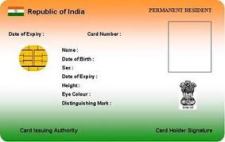Unique identification project was initially conceived by the Planning Commission as an initiative that would provide identification for each resident across the country and would be used primarily as the basis for efficient delivery of welfare services. It would also act as a tool for effective monitoring of various programs and schemes of the Government.
In 2006,two projects were on pipeline and approved by the Planning commission of India - 1. Unique ID for Below Poverty Line (BPL) families by the Department of Information Technology and 2. National Population Register and issuance of Multi-purpose National Identity Cards to citizens of India by Registrar General of India. Therefore, it was decided, with the approval of the Prime Minister, to constitute an empowered group of Ministers (EGoM) to collate the two schemes – the National Population Register under the Citizenship Act, 1955 and the Unique Identification Number project of the Department of Information Technology.
In pursuance of the Empowered group of Ministers' fourth meeting dated 04 November 2008, the Unique Identification Authority of India was constituted and notified by the Planning Commission on 28 January 2009. The role and responsibilities of the UIDAI was laid down in this notification. The UIDAI was given the responsibility to lay down plan and policies to implement UIDAI scheme and shall own and operate the UIDAI database and be responsible for its updation and maintenance on an ongoing basis
Who lead UIDAI
Chairman : Nandan Nilekani is currently the Chairman of the Unique Identification Authority of India (UIDAI)—which aims to provide a unique identification number for all residents of India—in the rank and status of a Cabinet Minister.
DG and Mission Director : The Chief Executive Officer of the Project i.e. Director General and Mission Director has been appointed. Mr. R.S. Sharma has been appointed as the first Director General of the UIDAI. He is an Additional Secretary Rank Officer belonging to the 1978 batch of the Indian Administrative Service.
About Aadhaar
Aadhaar is a 12-digit unique number which the Unique Identification Authority of India (UIDAI) will issue for all residents. The number will be stored in a centralised database and linked to the basic demographics and biometric information – photograph, ten fingerprints and iris – of each individual. The details of the data fields and verification procedures are available here.
Aadhaar will be:
- Easily verifiable in an online, cost-effective way
- Unique and robust enough to eliminate the large number of duplicate and fake identities in government and private databases
- A random number generated, devoid of any classification based on caste, creed, religion and geography
Why Aadhaar?
Aadhaar-based identification will have two unique features:
Universality, which is ensured because Aadhaar will over time be recognised and accepted across the country and across all service providers.
Every resident's entitlement to the number.
The number will consequently form the basic, universal identity infrastructure over which Registrars and Agencies across the country can build their identity-based applications.
Unique Identification of India (UIDAI) will build partnerships with various Registrars across the country to enrol residents for the number. Such Registrars may include state governments, state Public Sector Units (PSUs), banks, telecom companies, etc. These Registrars may in turn partner with enrolling agencies to enrol residents into Aadhaar.
Aadhaar will ensure increased trust between public and private agencies and residents. Once residents enrol for Aadhaar, service providers will no longer face the problem of performing repeated Know Your Customer (KYC) checks before providing services. They would no longer have to deny services to residents without identification documents. Residents would also be spared the trouble of repeatedly proving identity through documents each time they wish to access services such as obtaining a bank account, passport, or driving license etc.
By providing a clear proof of identity, Aadhaar will empower poor and underprivileged residents in accessing services such as the formal banking system and give them the opportunity to easily avail various other services provided by the Government and the private sector. The centralised technology infrastructure of the UIDAI will enable 'anytime, anywhere, anyhow' authentication. Aadhaar will thus give migrants mobility of identity. Aadhaar authentication can be done both offline and online, online authentication through a cell phone or land line connection will allow residents to verify their identity remotely.
Who can get an Aadhaar?
An individual who is a resident in India and satisfies the verification process laid down by the UIDAI can get an Aadhaar.
Latest News on UIDAI and Aadhaar
30,June,2011 : In just nine months since the launch of the Aadhaar project in Maharashtra, UIDAI has issued one crore Aadhaar numbers. 52 year old, NK Chheda from Maharashtra has the distinction of being the resident whose Aadhaar number was generated on reaching this milestone. Coincidentally, the first resident to get the Aadhaar number, Ranjana Sonawane, is also a resident of Maharashtra. She received her number on 29th September, 2010 in Tembhli village of Nandurbar district.






0 comments: